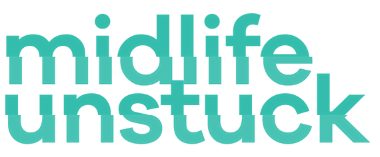How to free yourself from the work stories you tell yourself (that can keep you stuck forever)
The daily stories we tell ourselves about our work and career, often keep us stuck in exactly the same situation…for a very long time. It doesn’t have to be that way.
Are you’re tired of hearing yourself tell the same stories about the problem of your work? Then read how to free yourself with these simple, yet surprisingly tricky, strategies to begin to find your solution.
4 work stories we tell ourselves, that keep us stuck
Check out the more detailed article I wrote about the 4 work stories we all tell ourselves that stop us designing work that we might love.
Here’s a recap:
Blame stories - attributing fault to “them” or “me”
Impossibility stories - rehearsing reasons why nothing could ever change
Zero-accountability stories - denying any responsibility for the situation…or any power to change it
Invalidation stories - deciding that feelings, desires, thoughts, or personalities are “wrong”
What to do instead…
The good news is that we don’t have to keep telling ourselves stories that keep us stuck.
There is another way.
4 Methods to change problem stories into solution stories
In my work, I use four VERY EFFECTIVE ways to challenge sticky problem stories, giving my clients the freedom to begin to write different work stories - solution stories.
These solution stories give our brains the freedom to create new possibilities.
Sometimes this leads to a radical change, but more often than not, a few of the right tweaks can make the world of difference.
My personalised redesign programme incorporate all of these methods in a very supportive, one-on-one environment, with very tangible results.
These methods can seem both simple and brain-tingling difficult, at the same time.
See what you think.
Acknowledge and describe
It’s tricky to take the emotion out of our work situations - especially if it’s been going on for some time. These emotions can get in the way of clear thinking.
Doing work that isn’t as satisfying or fulfilling as we’d like, can get messy emotionally.
Ego gets in the way
Self-worth issues come up
Conflicting motivations sprout
Our harsh judgements of ourselves, others, and situations blur our clarity
Fear of what might happen if we admit the true situation spills out
Here is the first method to change problem work stories into solution stories. It involves clearly and specifically describing your current situation, without judgements, explanation, forecasts, or blame.
Grab a pen and write down why you’re feeling stuck at the moment for you.
Are there particular experiences, people or situations that are making you feel stuck?
How are these things impacting you across all areas of life - emotional and physical health? Fun? Sleep? Connection with family and friends?
To help you do this as easy as possible, I recommend you check out Derailed! It’s a mini programme that does this for you and your results are often eye-opening.
2. Find or create counter-evidence
If you’ve been stuck thinking about the problem of work for years, it’ll take some effort to pull back the covers on evidence that doesn’t fit with the old, familiar problem story.
You can shift problem stories towards solution stories, by seeking out evidence that doesn’t fit with the problem story.
A personal story.
This method had a massive impact on helping me change my “problem of work” story.
I realised that I knew no one, not one single person, who had changed careers in their 40s and were happier for it.
My search for counter-evidence started with a simple Google search “career change stories after 40”. This made me wonder whether any famous people had shifted their careers, and whether they had still been successful after doing so (here’s what I found out).
This research then became more practical. I asked around on social media if anyone knew someone who had changed careers after 40 and were happier for it. Then I had telephone calls with 100 of them! Which then became the basis for my little book of career change hope and my new career.
If that sounds a bit daunting, I’ve made this one dead easy for you:
Check out my book on the patterns I discovered about changing career post 40. It is based on those 100 interviews, with 20 deep dive stories into how they did it
I release a new midlife career change story every couple of weeks on my website - you can check them out here
3. Create helpful and compassionate stories
To write a more helpful story about our future work, we need to be kinder to ourselves. When we tell ourselves that we “should” feel, or be, a certain way, we’re very likely to feel bad about how we actually feel.
In my spare time, I used to be a bereavement support volunteer for the wonderful charity CRUSE. The individuals who asked for help had somehow got stuck beyond the normal grieving process (what’s normal anyway?!). They’d often use the word “should” to describe how they felt.
The “should” was unhelpful. It held them back.
It’s the same in our work.
When we tell ourselves that we “should” feel or be a certain way, we’re very likely to feel bad about ourselves.
It’s not helpful to say any of these type of statements:
I should stay where I am - I might never get another job if I leave
I should feel happier with my lot - I have X, Y and Z
I should have dealt with X better
I should be able to do X better with my experience
I should be grateful for my situation
This shouldn’t be so difficult, I just need to X
These stories hinder our ability to begin to craft more satisfying and fulfilling work.
We need to try to show more compassion to ourselves and our situations.
Where possible, it might be good to delete the word “should” from our daily vocabulary. Believe me, this takes some work.
But it’s worth it.
This makes it possible to write new stories that help us understand ourselves and our situations more clearly…
…so that we can create new possibilities.
4. Realise that your future story could be different to your current story
Pick up a pen to write your new story - there are proven scientific links between hand-writing and creative thinking,
Here’s what I firmly believe:
We could have lived so many different lives if we’d taken different roads, made different choices, or met different people.
The past is gone.
But we still can live lots of different lives available to us - by widening the possibilities for our future story.
Little step by little step. Not in one giant leap.
Our lives, if they ended tomorrow, will tell our story.
If we’re lucky enough to have more time than that, we could choose to write a new story.
Next steps
Changing problem stories into solution stories, is the psychological imbedded within my personal redesign programmes and the Fierce Emporium.
Your new story then forms the foundations of the next steps and decisions in your new career.
Here’s an email from Chris, a Project Manager, who worked with me one-to-one. It made my day when I received it.
“In all sincerity, I would not have found this role had I not a) consciously decided to escape my previous employer before it spat me out even closer to 50 and b) gone in to meet [the new company] in a positive mindset, being clear on what I do well and what I wanted.
I re-read your summary report on the way in to the interview this morning.
Both of these I have to give you full credit for, so sincere thanks go out to you for all your help.”
Book in here to discuss your career and which programme might be best for your situation.
If you liked this you might like these:









